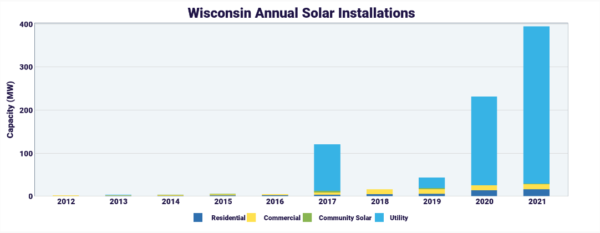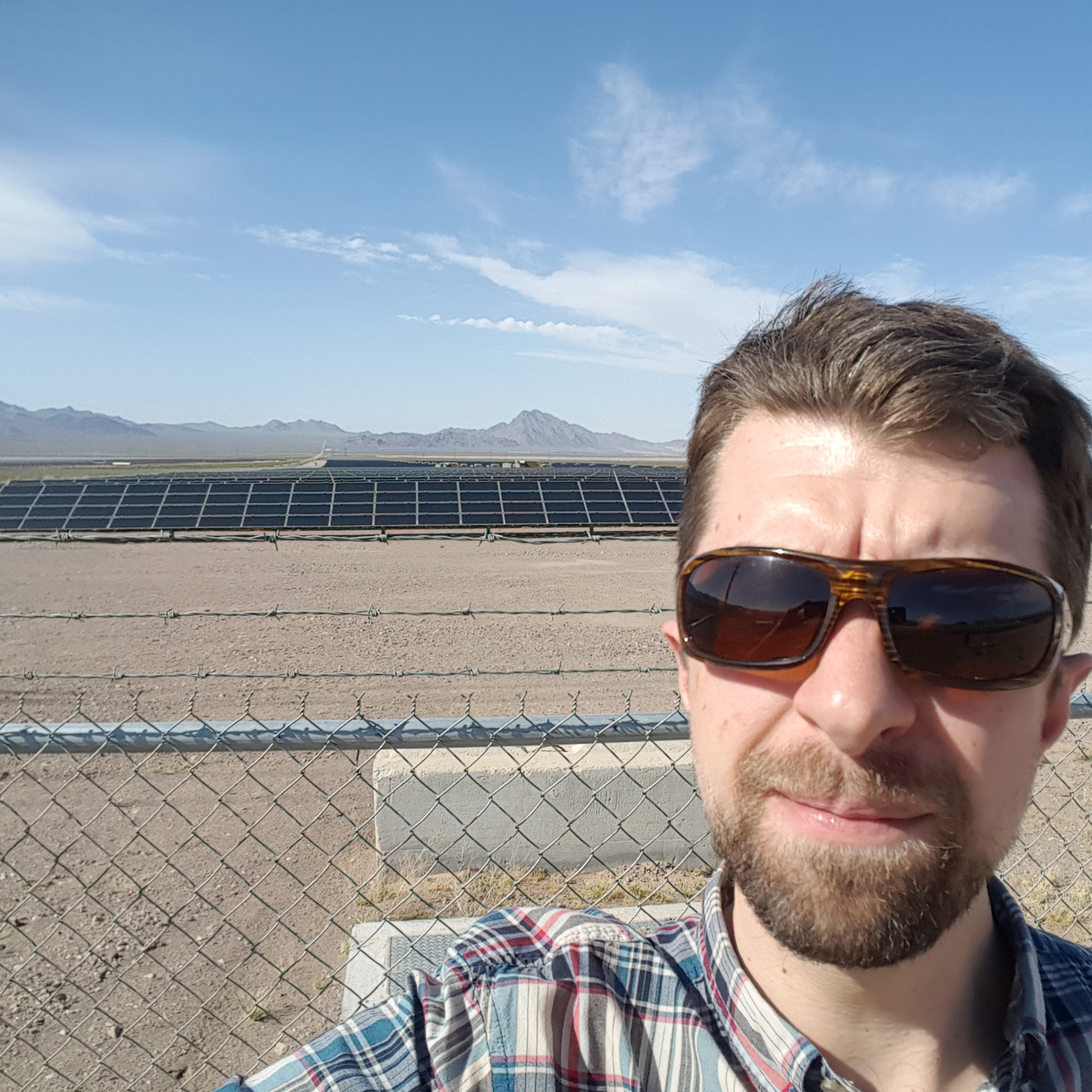The pv magazine USA tour of solar incentives last stop was Louisiana, and now moves into Wisconsin.
Ranked 23th in the nation according to the Solar Energy Industries Association (SEIA), Wisconsin has a relatively low electricity rate, at 16 cents per kWh, per the U.S. Energy Information Administration (EIA), 21% lower than the national average.
Wisconsin’s industrial sector, including agriculture, food and beverage product manufacturing, is the state’s largest energy-consuming sector, with industrials representing 31% of the state’s total energy consumption.
The state’s robust agricultural market ranked it ninth in the nation in fuel ethanol production capacity, producing close to 600 million gallons of ethanol per year from just nine facilities. Coal power continues to dominate, at 42% of the Badger State’s energy mix, but down sizably from a whopping 82% of the portfolio mix in 1997, according to the EIA.
Nevertheless, the state’s vast industrial network makes Wisconsin’s energy consumption six times the rate of which it produces energy, creating fertile ground for a proactive renewable energy portfolio standard (RPS).
Wisconsin became the first state to create a renewable portfolio standard (RPS) in 1999 without restructuring its utility market. In 2006, Act 141 was enacted, which requires the Wisconsin Public Service Commission to revise its integrated resource plan and energy efficiency program every four years, a proactive approach to energy policy in a historic coal and gas state.
While the state has favorable residential and utility solar regulations for development, community solar access for residents or small businesses has faltered in as utilities continue to block community access to small-solar projects.
Net metering
The state’s PSC in 1982 filed an order that required utilities to file tariffs allowing net metering to customers that generate electricity of up to 20 kW per household or business.
The PSC has no administrative rules for net metering. Customer net excess generation (NEG) is generally credited at the utility’s retail rate for renewables and at the utility’s avoided-cost rate for non-renewable energy. Generally speaking the NEG credit is carried over to the customer’s next bill and if the NEG credit exceeds $25, then the utility is required to issue a credit to the customer for excess generation.
The net-metering standard governs solar as well as wind, biomass, geothermal, hydro and various other distributed generation projects.
Currently Xcel Energy has a 100 kW system size for net metering maximum, and the utility’s Northern States Power Company affiliate uses the NEG standard credit over monthly at the retail rate with customers compensated at the end of the calendar year at avoided cost rate.
Wisconsin Electric Power (We Energies) has a more proactive 300 kW net metering limit, with NEG credits reconciled monthly at a customer buyback rate of $0.04245 per kWh.
The state’s third major utility, Madison Gas and Electric also has a 100 kW net metered limit with monthly NEG credit reconciliation that factors in energy, capacity and transmission costs.
 Distributed generation
Distributed generation
On December 9, the Wisconsin PSC approved Madison Gas and Electric (MGE) to purchase solar energy and battery storage power capacity from the Darien Solar Energy Center, a $478 million, 250 MW solar plus 75 MW battery storage facility to be built by Invenergy.
WEC Energy Group subsidiaries We Energies and Wisconsin Public Service will own the remaining 225 MW of the solar output and 67.5 MW of battery storage from the project, though their purchase arrangement has yet to be approved.
“The Darien Solar Energy Center is another important step in our ongoing transition to cleaner energy sources, reducing carbon at least 80% by the end of this decade and achieving net-zero carbon electricity by 2050,” said Jeff Keebler, chairman, president and chief executive officer of Madison Gas.
WEC Energy told the public that the distributed generation project is needed to help meet capacity requirements as the utility retires a 1.39 GW coal-fired power fleet over the next four years. For its part, Madison Gas is seeking to replace its share of the coal-fired Columbia Energy Center, which is also scheduled to shut down by 2026.
Over the last two years, Wisconsin has catapulted its solar use, with 1.13 GW of installed capacity as of September 30, as the state brought online a strong 495 MW of solar capacity in 2021. The state’s utilities are in better position to see more development like Darien Solar, with an impressive 4.25 GW growth pipeline for solar deployments over the next five years.
Invenergy completed an earlier project, Badger Hollow in Montfort, Wisconsin, which at 300 MW capacity contributed to the uptick in recent solar deployments when it came online in 2021.
Community solar
Unlike its two Midwest neighbors Illinois and Minnesota, Wisconsin still lacks broader policy framework allowing for the community engagement and participation in solar projects at the local level. With rooftop solar rules allowing net metering, while its trio of public utilities reaps the benefit of a growing solar and storage portfolio, local consumers do not yet have access to community solar.
Proposed community solar legislation (SB 490 / AB 527) did not pass during a 2021-22 state session. “We made great progress in educating and building support with various stakeholders and the legislature about this method of delivering solar energy,” said Jim Boullion, director of government affairs of RENEW Wisconsin.
So far about 16 corporations such as Arcadia, Generac, and local groups have expressed public support of community solar (SB 490) becoming state law in Wisconsin during the next state session, which reconvenes in January 2023. Each of the state’s public utilities have opposed the community solar mandate.
Landmark installation
The Badger Hollow solar facility in Montfort became the first large-scale utility project to enter commercial operations in Wisconsin in November 2021. Developed also by Invenergy, the 300 MW project provides enough clean energy to power more than 77,100 homes. Local reports say the 1,100-acre site for the project in Iowa County, Wisconsin has co-located hog farming operations, with the project providing tax revenue from the shared leasing of the facility on farmland.
Madison Gas and Wisconsin Public Service (WPS), a subsidiary of WEC Energy Group, share a combined 150 MW of the power output from the Badger Hollow facility, while Madison Gas also purchased an additional 50 MW of output of the first 150 MW phase of the project from 2019. The two utilities also committed to purchasing the 150 MW output from the second phase of the project in 2020. Badger Hollows features 500,000 solar panels spread across the large acreage.
Up next
The next stop on the pv magazine USA tour of solar incentives will take us south to Texas.
This content is protected by copyright and may not be reused. If you want to cooperate with us and would like to reuse some of our content, please contact: editors@pv-magazine.com.









By submitting this form you agree to pv magazine using your data for the purposes of publishing your comment.
Your personal data will only be disclosed or otherwise transmitted to third parties for the purposes of spam filtering or if this is necessary for technical maintenance of the website. Any other transfer to third parties will not take place unless this is justified on the basis of applicable data protection regulations or if pv magazine is legally obliged to do so.
You may revoke this consent at any time with effect for the future, in which case your personal data will be deleted immediately. Otherwise, your data will be deleted if pv magazine has processed your request or the purpose of data storage is fulfilled.
Further information on data privacy can be found in our Data Protection Policy.